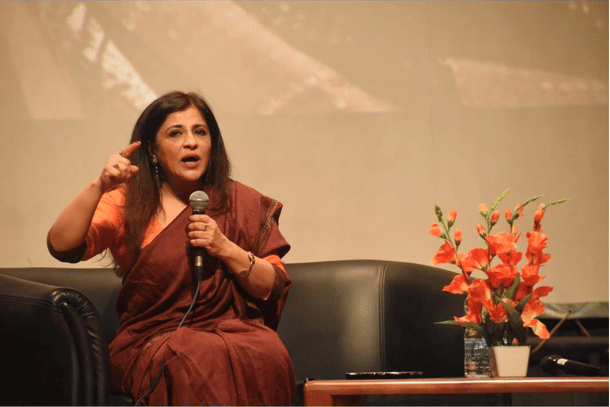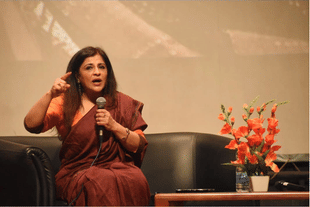Blogs
Montage, Malice, And Manipulation!
Shazia Ilmi
Aug 01, 2024, 01:08 PM | Updated 01:08 PM IST
Save & read from anywhere!
Bookmark stories for easy access on any device or the Swarajya app.


It was the seminal silent film Battleship Potemkin, released in 1925, that first drew international attention to Soviet cinema. Based on revolutionary ideas of working-class rebellion, the film’s potential to arouse passions led to its ban in the United Kingdom until 1954.
However, it was not just the powerful content of the film that made it cinematically iconic, but the technique employed in its distinctive editing style called "montage" that made the art world sit up in rapt attention.
The Soviet montage theory first illustrated how different visuals disconnected by the unity of time, place, and action can be juxtaposed to create a new powerful emotion or effect.
The acclaimed Russian film theorist delved into a new form of editing by playing around with disparate images. He believed that two or more images edited together create a third thing, a new meaning that is greater than the sum of its individual parts.
After Battleship Potemkin came the acclaimed film October: Ten Days That Shook the World in 1928, which was a celebratory dramatisation of the 1917 Bolshevik Revolution commissioned by none other than Joseph Stalin.
And that’s how the editing technique of Russian montage transformed into a powerful tool, transforming cinema into political propaganda.
Let’s try and understand the manipulation of editing in what I think would be the most elementary of examples.
Say the first visual is a long shot of a gun-toting ruffian entering the frame left to right in a lone street. The second shot is a long shot (wide) of two school girls walking from right to left of the frame.
The third shot depicts a close-up of the trigger-happy man.
The fourth shot shows one of the girls on the floor, blood everywhere.
The fifth shot depicts a close-up of the other girl crying.
The sixth shot shows the ruffian running away.
Put together these visuals in a certain order, and we will all swear and testify that the man indeed shot one of the girls.
The illusion created by the manipulation of editing would have all of us believe that the crazy ruffian shot one of the school girls and ran off.
Yet there is not a single frame connecting him to either the girls or the shooting.
Recently, a news anchor who’s more of a political propagandist than a journalist cut out my audio, prompting me to leave the show.
He disagreed with my views on the Agnipath scheme and pitched the statements of former Chief of Army Staff General M M Naravane against the former and current Chiefs of Defence Staff as well as the former Army Chief General Manoj Pande, constantly heckling and speaking over.
I held my ground despite his intolerance. However, when my audio was cut off, I saw little point in suffering ad nauseam from the biased blabber!
But there was a slight issue, and run off I couldn’t. My mobility is restricted thanks to an ankle fracture. I hobbled my way up and decided to take off the microphone.
To my horror, the entire awkward activity of my unmiking was being telecast as a live feed. I hobbled across, hoping the unassuming cameraman would give me a hand and help me with the wheelchair, which was kept afar as to avoid being seen in the TV frame.
And because I was now standing, my upper torso was fully in frame, with the camera capturing my gawky removal of the microphone and also my ungainly gait.
(After all, we as spokespersons only bargain for the standard ‘talking heads’ frame, which is essentially head and shoulders mid-shot and nothing below. Understandably, this sensitive protocol or visual propriety becomes particularly important for a woman.)
There is a standard practice followed by all camera crews to avoid recording the delicate process of miking and unmiking by women, lest it make one feel uncomfortable.
I squirmed in discomfort and limped my way towards my bedroom. I’m not supposed to put pressure on my left foot. My helper was on the other side of the camera, and she seemed too petrified to help.
The daft bloke continued to record. When I told him to stop the recording, he said he was getting instructions not to. He had had a coffee before the show, and we had even discussed the details of my foot injury. So I could not understand why he couldn’t communicate to the PCR, that is, the TV production control room, that I have a foot fracture and do not wish to have a camera recording every activity in minutiae.
I turned back and hurdled towards him and physically turned the camera lens away from me.
My discomfiture had peaked, and I screamed at him and told him to leave my house.
In all of the last two decades of television (anchoring included) and at least thousands of TV debates (say, an average of two to three shows daily, 365 days x 20 odd years), I had never encountered such a trying situation.
The laws of privacy are very clear. I had the right to call security and have the footage taken against my consent confiscated. I wish I had thought of it then.
The next day, this sly propagandist decided to emulate Sergei Eisenstein and make a little story about how rude I was to a hapless cameraman. He did not mention that all of this happened post facto and had nothing to do with the misinformation he was peddling on TV.
His editor used three different shots to create a 'smear film’. He used the shot of me taking off the microphone, where my awkwardness is all too visible to be seen, my hobbling across to turn the lens away, and another random shot of the car interior to create a lie.
Everyone saw that the microphone was not thrown but kept carefully on the table.
Everyone heard that I never used any expletives. I screamed at him to get away. Did his fancy media house actually expect me to offer his cameraman pyjamas for a sleepover and a hot chocolate to go with?
It was obvious from the cleverly edited clip that considerable time had elapsed between the first and second clips. In the second clip, my hair was piled up, whereas before that, it was not. There was a cut between three clips, which shows three different shots and not a continuous one, where a large chunk was clumsily edited out.
A random shot of a car interior to depict how the cameraman had to flee without realising there are four floors between my apartment and the car park.
Now Sergei Eisenstein would have never been as ludicrous and dishonest as this.
Not stopping at this, this smear film was posted on his X timeline to malign me and distract attention away from his intolerance.
Just like this bright spark gave away the premeditated walkout of Mamata Banerjee from the NITI Aayog meeting a day in advance, he gave up his own illegal secret recording of a lady without her consent, in his own tweet (X post), incriminating himself.
Bless his brilliance!
This mischievous art of editing rampant in social media must be called out. Scores of individuals are being targeted and maligned on a daily basis.
Just because I represent a political party he works against as a corporate honcho doesn’t give him the right to harass me. Three separate images and footage from different time chunks were used. My safe space at home was violated. I was filmed beyond the show without my consent.
Camera protocols were clearly flouted. Basic concern for someone’s physical health was thrown asunder.
Why?
Just to pander to the tantrums of an ego-tripping media czar of hubris!
Shazia Ilmi is National Spokesperson, BJP





